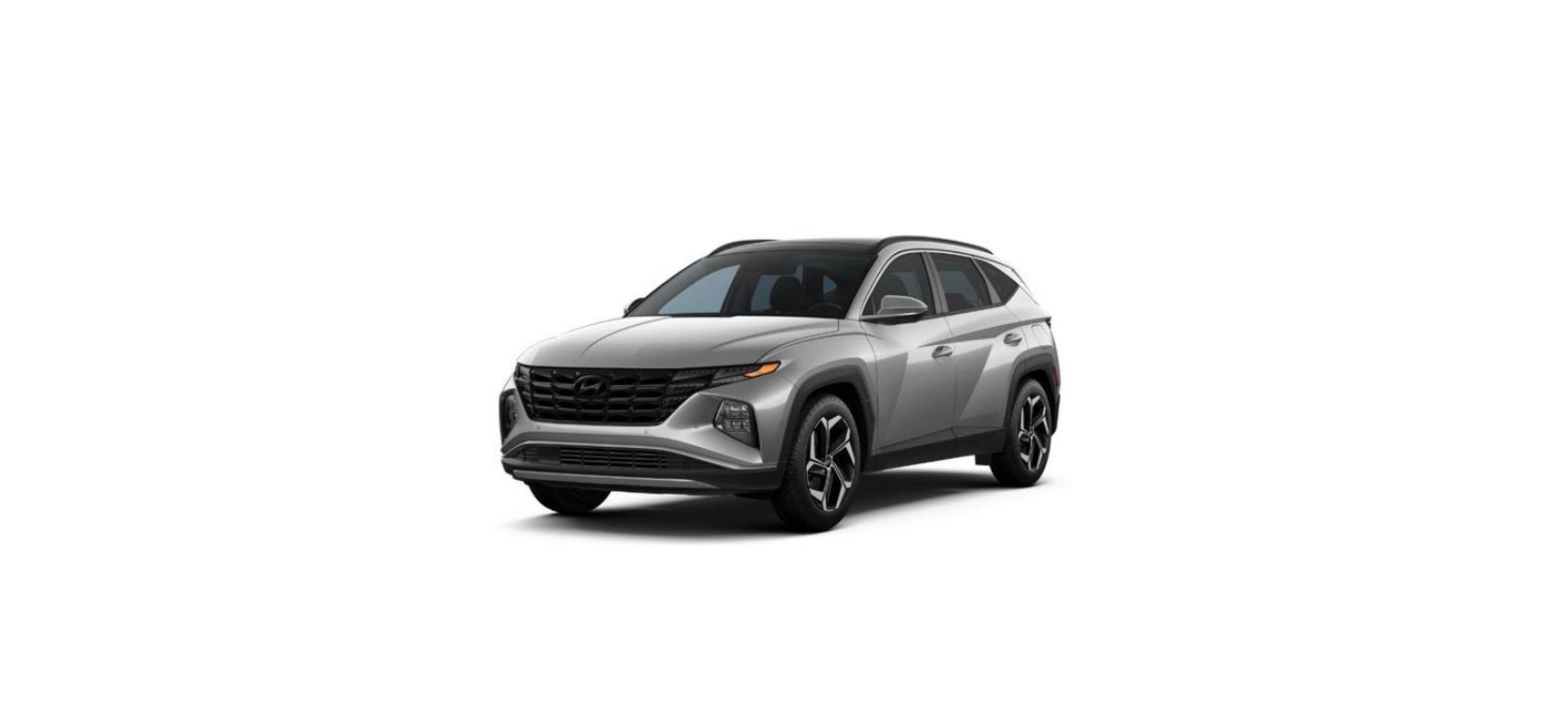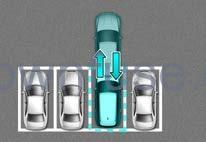2022 Hyundai Tucson Parking Safety
 REARVIEW MONITOR (RVM) (IF EQUIPPED)
REARVIEW MONITOR (RVM) (IF EQUIPPED)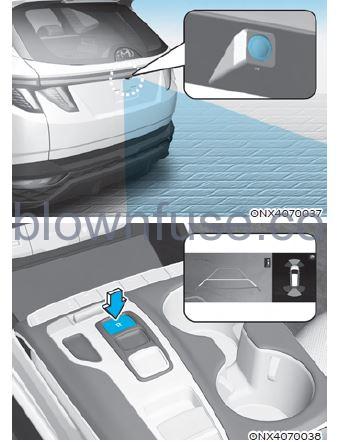
Rear View Monitor will show the area behind the vehicle to assist you when parking or backing up.
Camera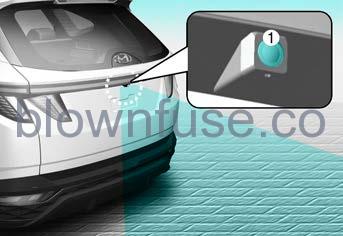
Refer to the picture above for the detailed location of the camera.
Rear View Monitor Settings
Camera settings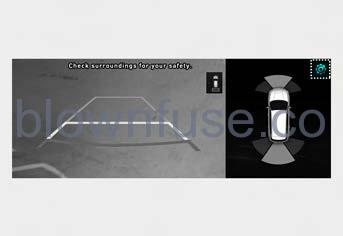
You can change Rear View Monitor to‘ Display Contents’ or ‘Display Settings’ by touching the setup icon ( ) on the screen while Rear View Monitor is operating, or selecting ‘Driver Assistance → Parking Safety → Camera Settings’ from the Settings menu while the engine is on.
- In the Display Contents, you can change settings for ‘Rear View’, and in the Display Settings, you can change the screen’s ‘Brightness’ and ‘Contrast’.
Rear View Monitor Operation
Operating button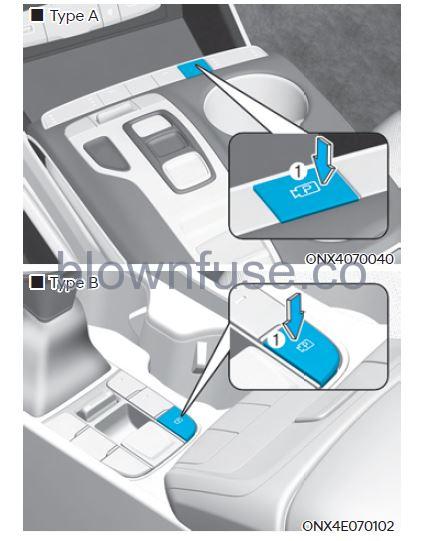
Parking/View button Press the Parking/View button (1) to turn on Rear View Monitor. Press the button again to turn off the function.
Rearview
Operating conditions
- Shift the gear to R (Reverse), the image will appear on the screen.
- Press the Parking/View button (1) while the gear is in P (Park), and the image will appear on the screen. Off conditions
- The rearview cannot be turned off when the gear is in R (Reverse).
- Press the Parking/View button (1) again while the gear is in P (Park) with the rear view on the screen, the rearview will turn off.
- Shift the gear from R (Reverse) to P (Park), the rearview will turn off.
The extended rearview function
The rearview will maintain showing on the screen to help you when parking.
Operating conditions
Shift the gear from R (Reverse) to N (Neutral) or D (Drive), the rearview will appear on the screen. Off conditions
- When the vehicle speed is above 6 mph (10 km/h), the rearview will turn off.
- Shift the gear to P (Park), the rear view will turn off.
- If you press the Parking/View button, the screen is off
Rear top view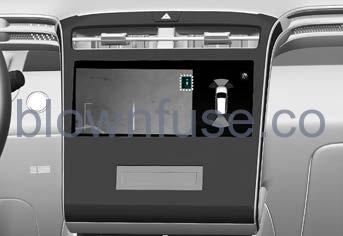
When you touch the icon, the top view is displayed on the screen and shows the distance from the vehicle in the back of your vehicle while parking.
Rear View Monitor Malfunction and Limitations
Rear View Monitor malfunction
- When Rear View Monitor is not working properly, or the screen flickers or the camera image does not display normally, have the vehicle inspected by an authorized HYUNDAI dealer.
- Limitations of Rear View Monitor When the vehicle is stopped for a long time in winter or when the vehicle is parked in an indoor parking lot, the exhaust fumes may temporarily blur the image.
WARNING
- The rearview camera does not cover the complete area behind the vehicle. The driver should always check the rear area directly through the inside and side-view mirror before parking or backing up.
- The image shown on the screen may differ from the actual distance of the object. Make sure to directly check the vehicle’s surroundings for safety.
- Always keep the rearview camera lens clean. If the lens is covered with foreign material, it may adversely affect camera performance and Rear View Monitor may not operate normally. However, do not use chemical solvents such as strong detergents containing high alkaline or volatile organic solvents (gasoline, acetone, etc.). This may damage the camera lens.
SURROUND VIEW MONITOR (SVM) (IF EQUIPPED)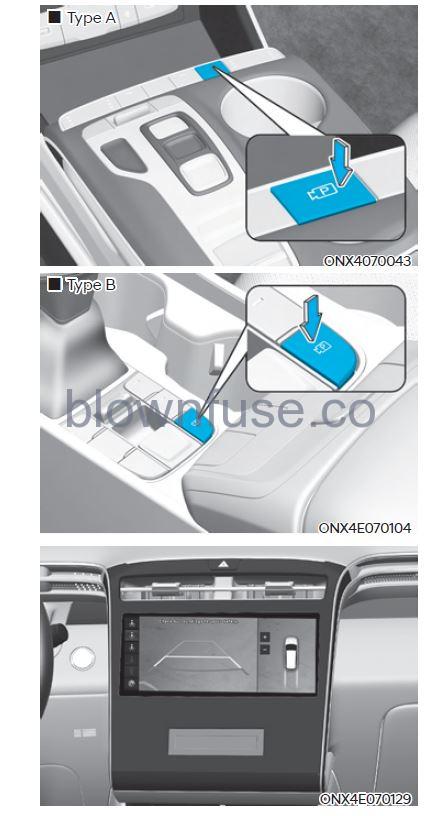
Surround View Monitor can help assist in parking using the cameras installed on the vehicle and displays images around the vehicle through the infotainment system screen.
- The parking Assist View function helps the driver to see the surroundings of the vehicle in a parking situation in various view modes
Detecting sensor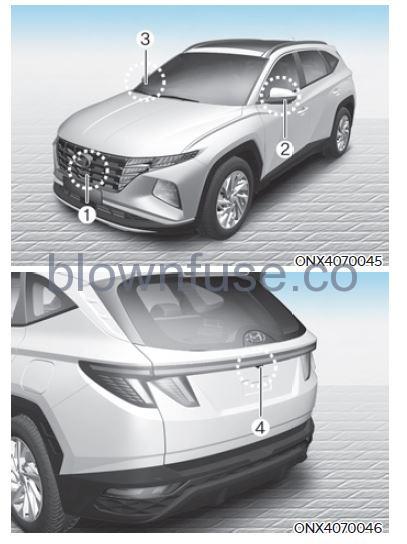
Refer to the picture above for the detailed location of the cameras.
Surround View Monitor Settings
Camera settings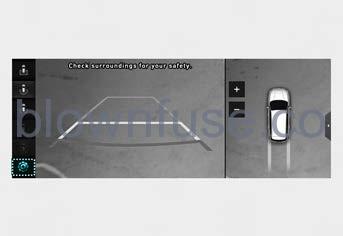
- You can change Surround View Monitor to‘ Display Contents’ or ‘Display Settings’ by touching the setup icon ( ) on the screen while Surround View Monitor is operating, or selecting ‘Driver Assistance → Parking Safety → Camera Settings’ from the Settings menu while the engine is on.
- In the Display Contents, you can change settings for ‘Top View Parking Guidance’, ‘Rear View Parking Guidance’, and ‘Parking Distance Warning’.
- In the Display Settings, you can change the screen’s ‘Brightness’ and ‘Contrast’.
Top View Parking Guidance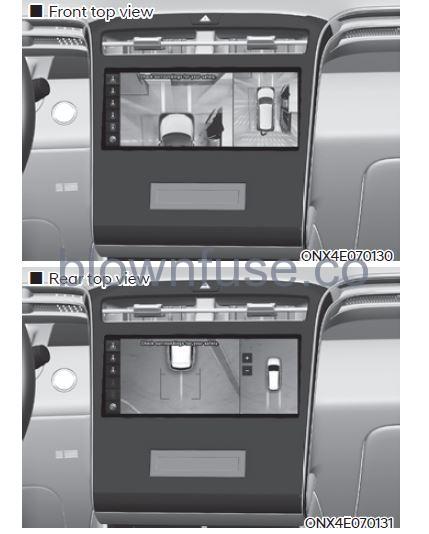
- When the ‘Top View Parking Guidance’ is selected, parking guidance is displayed on the right side of the Surround View Monitor screen.
- You may see the front top view or the rear top view when using Top View Parking Guidance.
- The ‘Top View Parking Guidance’ can be connected with the front top view parking guidance or the rear top view parking guidance.
Rear View Parking Guidance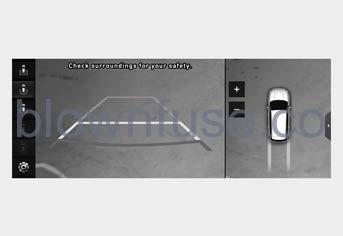
- When the ‘Rear View Parking Guidance’ is selected, parking guidance is displayed in the rearview.
- The horizontal guideline of the Rear View Parking Guidance shows the distance of 1.6 ft (0.5m), 3.3 ft (1 m), and 7.6 ft (2.3m) from the vehicle.
Parking Distance Warning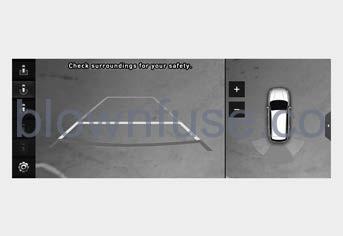
- When the ‘Parking Distance Warning’ is selected, the parking distance warning is displayed on the right side of the Surround View Monitor screen.
- The image will be displayed only when a Parking Distance Warning is warning the driver. Surround View Monitor Auto On With the engine on, select ‘Driver Assistance → Parking Safety → Surround View Monitor Auto On’ from the Settings menu to use the function
Surround View Monitor Operation
Operating button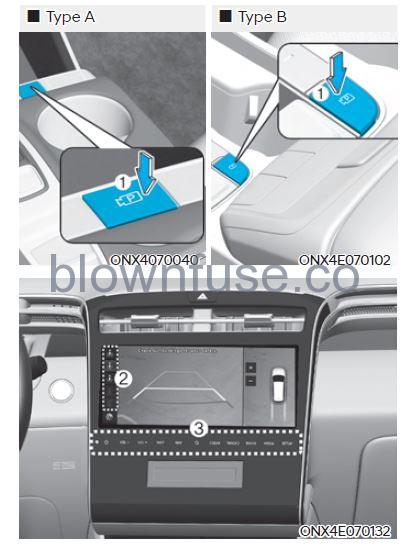
- Press the Parking/View button (1) to turn on Surround View Monitor. Press the button again to turn off the function.
- Other view modes can be selected by touching the view icons (2) on the Surround View Monitor screen.
- When one of the infotainment system buttons (3) is pressed without the gear in R (Reverse), the Surround View Monitor will turn off
Front view
The front image is displayed on the screen when the gear is in N (Neutral) or D (Drive) to assist in parking. The front view has a top view/front view/side view.
Operating conditions
- When the gear is shifted from R (Reverse) to N (Neutral) or D (Drive), the last set mode of the front view function will be selected.
- Front view function will operate when the following conditions are satisfied:
- While the infotainment system screen is being displayed, press the parking/View button (1) briefly when the gear is in D (Drive) or N (Neutral) and the vehicle speed is below 9 mph (15 km/h).
- Surround View Monitor Auto On function will operate when the following conditions are satisfied: — With ‘Driver Assistance → Parking Safety → Surround View Monitor Auto On’ selected from the Settings menu, the front parking assist view screen is displayed when Parking Distance Warning warns the driver while driving in D (Drive). Off conditions
- Press the Parking/View button (1) again, the image will turn off.
- When the vehicle speed is above 6 mph (10 km/h) with the gear in D (Drive), the Surround View Monitor will turn off and the screen will change back to the previous infotainment system screen. Although you drive below 6 mph (10 km/h) again, Surround View Monitor will not turn on.
- Press one of the infotainment system buttons (3), and the screen will change to the infotainment system screen.
- Shift the gear to P (Park), the image will turn off.
Rearview
The rear image is displayed on the screen when the gear is in R (Reverse) or P (Park) to assist in parking. The rear view has a top view/rearview/side view/3D view.
Operating conditions
- Shift the gear to R (Reverse), the image will appear on the screen.
- Press the Parking/View button (1) while the gear is in P (Park), and the image will appear on the screen.
Off conditions
- The image cannot be turned off when the gear is in R (Reverse).
- Shift the gear from R (Reverse) to P (Park), the image will turn off.
- Press the Parking/View button (1) again while the gear is in P (Park) with the image on the screen.
- When the vehicle is stopped for a long time in winter or when the vehicle is parked in an indoor parking lot, the exhaust fumes may temporarily blur the image.
- The screen may be displayed abnormally, and an icon will appear at the top left side of the screen under the following circumstances:
- The liftgate is opened
- The driver or front passenger door is opened
- The side view mirror is folded
WARNING
- ALWAYS look around your vehicle to make sure there are no objects or obstacles before moving the vehicle. What you see on the screen may differ from the actual vehicle’s location.
- The image shown on the screen may differ from the actual distance of the object. Make sure to directly check the vehicle’s surroundings for safety.
- Surround View Monitor is designed to be used on a flat surface. Therefore, if used on roads with different heights such as curbs and speed bumps, the image in the screen my not look correct.
- Always keep the camera lens clean. If the lens is covered with foreign material, it may adversely affect camera performance, and the Surround View Monitor may not operate normally. However, do not use chemical solvents such as strong detergents containing high alkaline or volatile organic solvents (gasoline, acetone, etc.). This may damage the camera lens.
REAR CROSS-TRAFFIC COLLISION-AVOIDANCE ASSIST (RCCA) (IF EQUIPPED)
Rear Cross-Traffic Collision-Avoidance Assist is designed to help detect vehicles approaching from the left and right side while your vehicle is reversing, and warn the driver that a collision is imminent with a warning message and an audible warning. Also, braking is assisted to help prevent a collision.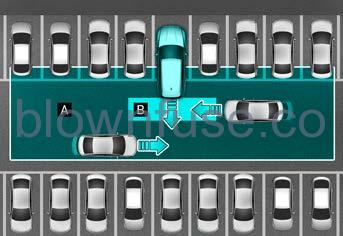
CAUTION
The time of warning may vary depending on the vehicle speed of the approaching vehicle.
Information
In the following text, Rear Cross-Traffic Collision Warning and Rear Cross-Traffic Collision-Avoidance Assist will be referred as Rear Cross-Traffic Safety system.
Detecting sensor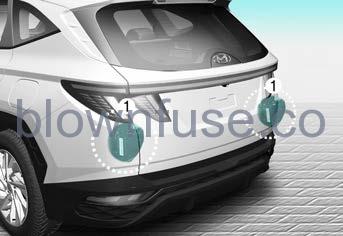
Refer to the picture above for the detailed location of the detecting sensors.
Information
For more details on the precautions of the rear corner radar, refer to the “Blind-Spot Collision-Avoidance Assist (BCA)” section in chapter 7.
Rear Cross-Traffic Safety System Settings
Setting features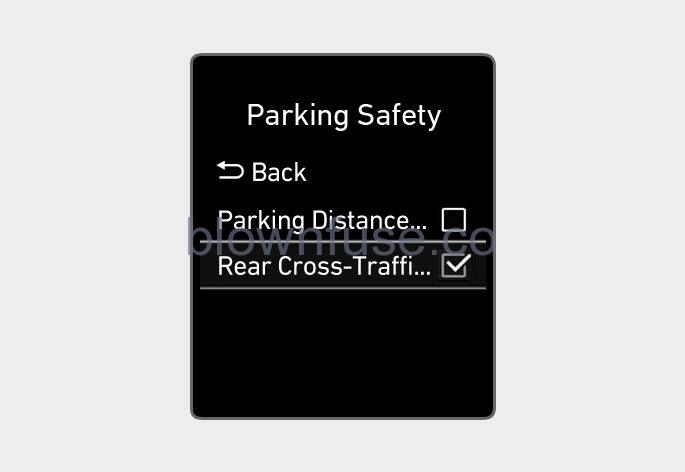
Rear Cross-Traffic Safety With the engine on, select ‘Driver Assistance → Parking Safety → Rear Cross-Traffic Safety’ from the Settings menu to turn on the Rear Cross-Traffic Safety system and deselect to turn off the system.
WARNING
When the engine is restarted, the Rear Cross-Traffic Safety system will always turn on. However, if ‘Off’ is selected after the engine is restarted, the driver should always be aware of the surroundings and drive safely.
Information
Settings for the Rear Cross-Traffic Safety system include Rear Cross-Traffic Collision Warning and Rear Cross-Traffic Collision-Avoidance Assist.
Warning Timing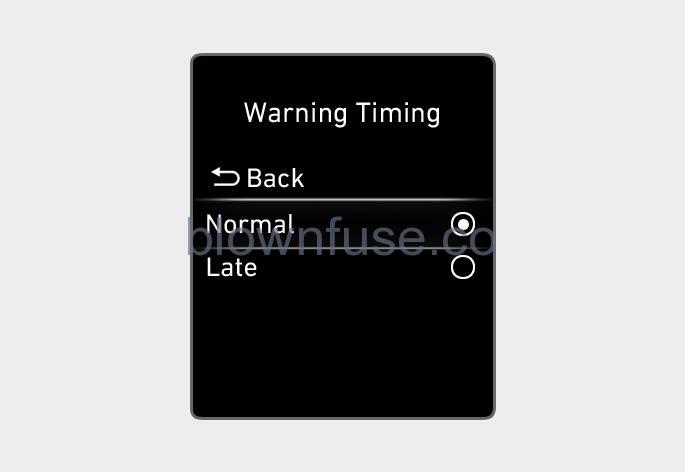
With the engine on, select ‘Driver Assistance → Warning Timing’ from the Settings menu to change the initial warning activation time for the Rear Cross-Traffic Safety system. When the vehicle is first delivered, Warning Timing is set to ‘Normal’. If you change the Warning Timing, the warning time of other Driver Assistance systems may change.
Warning Volume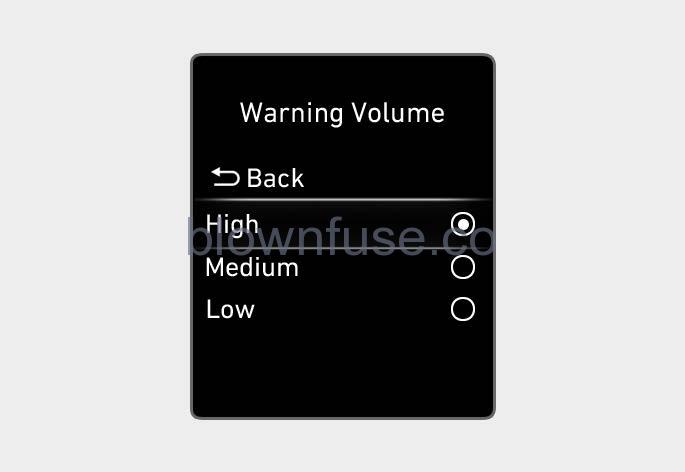
With the engine on, select ‘Driver Assistance → Warning Volume’ from the Settings menu to change the Warning Volume to ‘High’, ‘Medium’, or ‘Low’ for the Rear Cross-Traffic Safety system. If you change the Warning Volume, the Warning Volume of other Driver Assistance systems may change.
CAUTION
- The setting of the Warning Timing and Warning Volume applies to all functions of the Rear Collision-Avoidance Assist.
- Even though ‘Normal’ is selected for Warning Timing, if the vehicles from the left and right side approach at high speed, the initial warning activation time may seem late.
- Select ‘Late’ for Warning Timing when traffic is light and when driving speed is slow.
Information
If the engine is restarted, Warning Timing and Warning Volume will maintain the last setting.
Rear Cross-Traffic Safety System Operation
Warning and control
The Rear Cross-Traffic Safety system will warn and control the vehicle depending on the collision risk level: ‘Collision Warning’, ‘Emergency Braking’, and ‘Stopping vehicle and ending brake control’.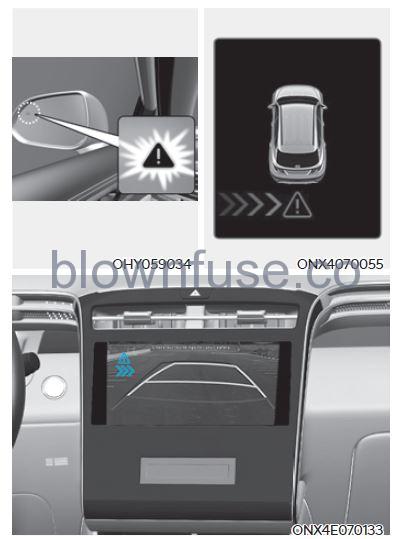
Collision Warning
- To warn the driver of an approaching vehicle from the rear left/right side of your vehicle, the warning light on the side view mirror will blink and a warning will appear on the cluster. At the same time, an audible warning will sound. If Rear View Monitor is operating, a warning will also appear on the infotainment system screen.
- The Rear Cross-Traffic Safety system will operate when all the following conditions are satisfied:
- The gear is shifted to R (Reverse)
- Vehicle speed is below 5 mph (8 km/h)
- The approaching vehicle is within approximately 82 ft. (25 m) from the left or right side of your vehicle
- The speed of the vehicle approaching from the left and right is above 3 mph (5 km/h)
Information
If the operating conditions are satisfied, there will be a warning whenever the vehicle approaches from the left or right side even though your vehicle speed is 0 mph (0 km/h).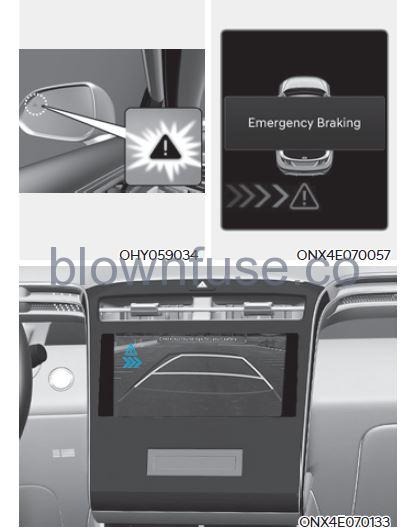
Emergency Braking
- To warn the driver of an approaching vehicle from the rear left/right side of your vehicle, the warning light on the side view mirror will blink and, the ‘Emergency Braking’ warning message will appear on the cluster. At the same time, an audible warning will sound. If Rear View Monitor is operating, a warning will also appear on the infotainment system screen.
- The Rear Cross-Traffic Safety system will operate when all the following conditions are satisfied:
- The gear is shifted to R (Reverse)
- Vehicle speed is below 5 mph (8 km/h)
- The approaching vehicle is within approximately 5 ft. (1.5 m) from the left or right side of your vehicle
- The speed of the vehicle approaching from the left and right is above 3 mph (5 km/h)
- Emergency braking will be assisted to help prevent collisions with approaching vehicles from the left and right.
Brake control will end when:
- The approaching vehicle is out of the detecting range
- The approaching vehicle passes behind your vehicle
- The approaching vehicle does not drive toward your vehicle
- The approaching vehicle speed slows down
- The driver depresses the brake pedal with sufficient power
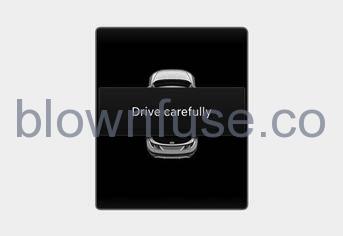
Stopping vehicle and ending brake control
- When the vehicle is stopped due to emergency braking, the ‘Drive carefully’ warning message will appear on the cluster.
- For your safety, the driver should depress the brake pedal immediately and check the surroundings.
- Brake control will end after the vehicle is stopped by emergency braking for approximately 2 seconds.
- During emergency braking, braking control by Rear Cross-Traffic Safety system will automatically cancel when the driver excessively depresses the brake pedal.
WARNING
Take the following precautions when using the Rear Cross-Traffic Safety system:
- For your safety, change the Settings after parking the vehicle at a safe location.
- If any other system’s warning message is displayed or an audible warning is generated, the Rear Cross-Traffic Safety system’s warning message may not be displayed and an audible warning may not be generated.
- You may not hear the warning sound of Rear Cross-Traffic Safety system if the surrounding is noisy.
- The Rear Cross-Traffic Safety system may not operate if the driver applies the brake pedal to avoid a collision.
- During the Rear Cross-Traffic Safety system operation, the vehicle may stop suddenly injuring passengers and shifting loose objects. Always have the seat belt on and keep loose objects secured.
- Even if there is a problem with Rear Cross-Traffic Safety system, the vehicle’s basic braking performance will operate normally.
- When the Rear Cross-Traffic Safety system is operating, braking control by the system will automatically cancel when the driver excessively depresses the accelerator pedal.
- The Rear Cross-Traffic Safety system does not operate in all situations or cannot avoid all collisions.
- The Rear Cross-Traffic Safety system may warn the driver late or may not warn the driver depending on the road and driving conditions.
- The driver is solely responsible to operate the vehicle in a safe manner. Do not solely depend on Rear Cross-Traffic Safety system. Rather, maintain a safe braking distance, and if necessary, depress the brake pedal to reduce driving speed or to stop the vehicle.
- Never deliberately operate Rear Cross-Traffic Safety system on people, animals, objects, etc. It may cause serious injury or death.
CAUTION
The brake control may not operate properly depending on the status of ESC (Electronic Stability Control). There will only be a warning when:
- The ESC (Electronic Stability Control) warning light is on
- ESC (Electronic Stability Control) is engaged in a different function
information
If the system assists you with braking, the driver must immediately depress the brake pedal and check the vehicle’s surroundings.
- Brake control will end when the driver depresses the brake pedal with sufficient power.
- After shifting the gear to R (Reverse), braking control will operate once for left and right vehicle approach
Rear Cross-Traffic Safety System Malfunction and Limitations
Rear Cross-Traffic Safety system malfunction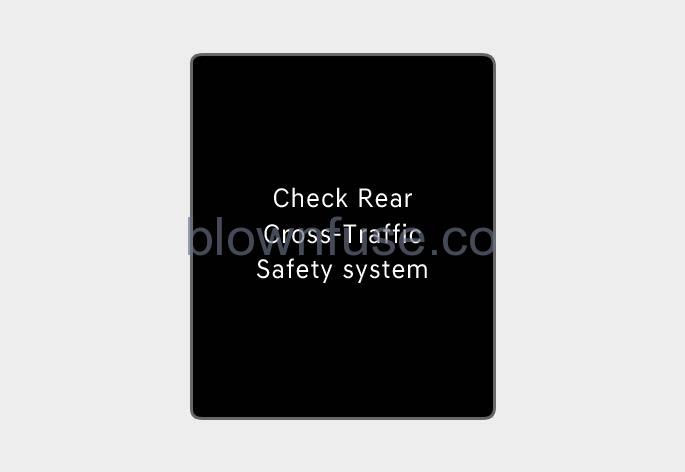
- When the Rear Cross-Traffic Safety system is not working properly, the ‘Check Rear Cross-Traffic Safety system(s)’ warning message will appear on the cluster, and the system will turn off automatically or the system will be limited. Has the vehicle been inspected by an authorized HYUNDAI dealer?
- When the side view mirror warning light is not working properly, the ‘Check side view mirror warning light’ (or ‘Check outside mirror warning icon’) warning message will appear on the cluster. Has the vehicle been inspected by an authorized HYUNDAI dealer?
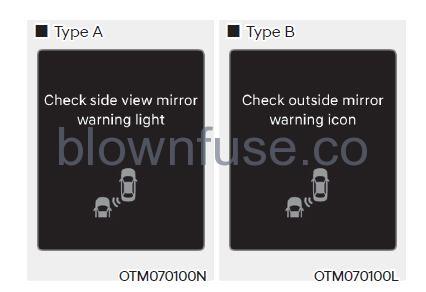
Rear Cross-Traffic Safety system disabled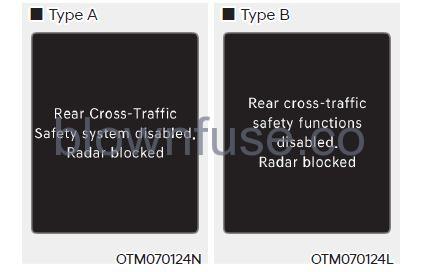
When the rear bumper around the rear side radar or sensor is covered with foreign material, such as snow or rain, or installing a trailer or carrier, it can reduce the detecting performance and temporarily limit or disable Rear Cross- Traffic Safety system. If this occurs, the ‘Rear Cross-Traffic Safety system disabled. Radar blocked’ (or ‘Rear cross-traffic safety functions disabled. Radar blocked’) warning message will appear on the cluster. The Rear Cross-Traffic Safety system will operate normally when such foreign material or trailer, etc. is removed. If the Rear Cross-Traffic Safety system does not operate normally after it is removed, have the vehicle inspected by an authorized HYUNDAI dealer.
WARNING
- Even though the warning message does not appear on the cluster, the Rear Cross-Traffic Safety system may not operate properly.
- A Rear Cross-Traffic Safety system may not operate properly in an area (for example open terrain), where any substances are not detected after turning ON the engine.
CAUTION
Turn off the Rear Cross-Traffic Safety system to install a trailer, carrier, etc., or remove the trailer, carrier, etc. to use the Rear Cross-Traffic Safety system.
Limitations of Rear Cross-Traffic Safety system
The Rear Cross-Traffic Safety system may not operate normally, or the system may operate unexpectedly under the following circumstances:
- Departing from where trees or grass are overgrown
- Departing from where roads are wet
- Speed of the approaching vehicle is fast or slow Braking control may not work, driver’s attention is required in the following circumstances:
- The vehicle severely vibrates while driving over a bumpy road, uneven road, or concrete patch
- Driving on a slippery surface due to snow, water puddle, ice, etc.
- The tire pressure is low or a tire is damaged
- The brake is reworked
- Remote Smart Parking Assist is operating (if equipped)
Information
For more details on the limitations of the rear corner radar, refer to the “Blind-Spot Collision-Avoidance Assist (BCA)” section in chapter 7.
WARNING
- Driving near a vehicle or structure Rear Cross-Traffic Safety system may be limited when driving near a vehicle or structure, and may not detect the vehicle approaching from the left or right. If this occurs, the system may not warn the driver or control the brakes when necessary. Always check your surroundings while backing up.
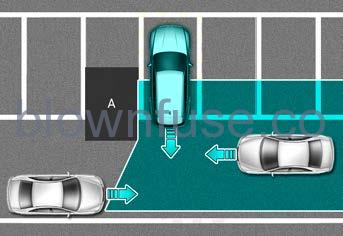
When the vehicle is in a complex parking environment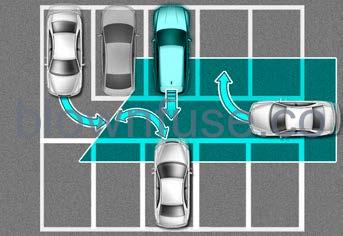
Rear Cross-Traffic Safety system may detect vehicles that are parking or pulling out near your vehicle (for example a vehicle leaving beside your vehicle, a vehicle parking or pulling out in the rear area, a vehicle approaching your vehicle making a turn, etc.). If this occurs, the system may unnecessarily warn the driver and control the brake. Always check your surroundings while backing up.
When the vehicle is parked diagonally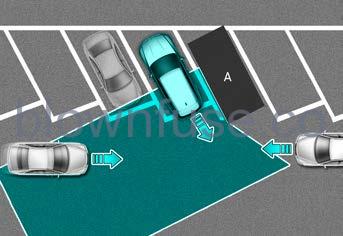
The Rear Cross-Traffic Safety system may be limited when backing up diagonally, and may not detect the vehicle approaching from the left or right. If this occurs, the system may not warn the driver or control the brakes when necessary. Always check your surroundings while backing up.
When the vehicle is on or near a slope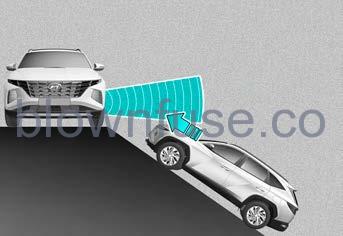
The Rear Cross-Traffic Safety system may be limited when the vehicle ison an uphill or downhill slope, or near it, and may not detect the vehicle approaching from the left or right. If this occurs, the system may not warn the driver or control the brakes when necessary. Always check your surroundings while backing up.
Pulling into the parking space where there is a structure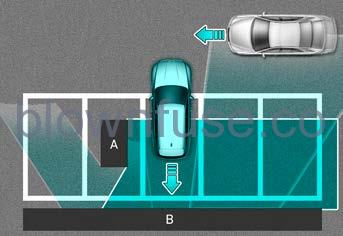
A Rear Cross-Traffic Safety system may detect vehicles passing by in front of you when parking in reverse into a parking space with a wall or structure in the rear or side area. If this occurs, the system may unnecessarily warn the driver and control the brake. Always check your surroundings while backing up.
When the vehicle is parked rearward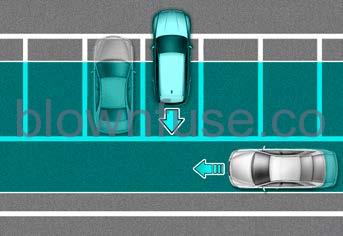
A Rear Cross-Traffic Safety system may detect vehicles passing by behind you when parking in reverse into a parking space. If this occurs, the system may unnecessarily warn the driver and control the brake. Always check your surroundings while backing up.
WARNING
- When you are towing a trailer or another vehicle, we recommend that the Rear Cross-Traffic Safety system is turned off due to safety reasons.
- A Rear Cross-Traffic Safety system may not operate normally if interfered with by strong electromagnetic waves.
- The Rear Cross-Traffic Safety system may not operate for 3 seconds after the vehicle is started, or the rear corner radars are initialized.
Information
This device complies with Part 15 of the FCC rules. Operation is subject to the following three conditions:
1. This device may not cause harmful interference, and
2. This device must accept any interference received, including interference that may cause undesired operation.
3. Changes or modifications not expressly approved by the party responsible for compliance could void the user’s authority to operate the device. Information Radio frequency radiation exposure
information
- This equipment complies with FCC radiation exposure limits set forth for an uncontrolled environment.
- This equipment should be installed and operated with a minimum distance of 8 in. (20 cm) between the radiator (antenna) and your body.
- This transmitter must not be co-located or operating in conjunction with any other antenna or transmitter.
REVERSE PARKING DISTANCE WARNING (PDW) (IF EQUIPPED)
Reverse Parking Distance Warning will help warn the driver if an obstacle is detected within a certain distance when the vehicle is moving in reverse at low speeds.
Detecting sensor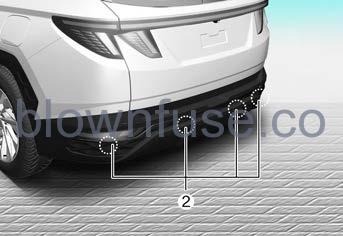
Refer to the picture above for the detailed location of the detecting sensors.
Reverse Parking Distance
Warning Settings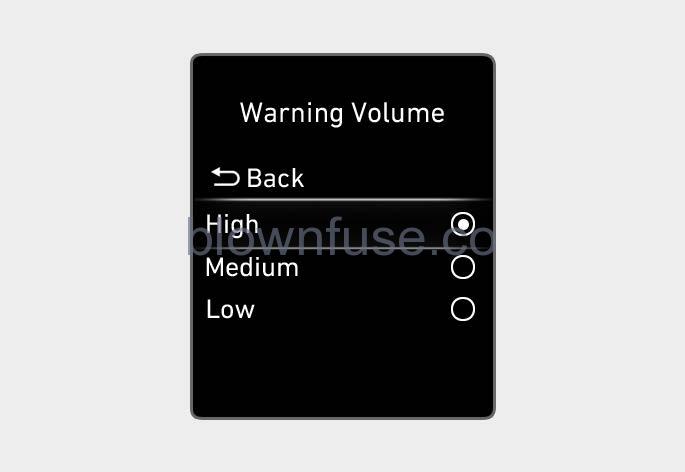
Warning Volume Select ‘Driver Assistance → Warning Volume’ from the cluster or infotainment system Settings menu to change the Warning Volume to ‘High’, ‘Medium’, or ‘Low’ for Reverse Parking Distance Warning. If you change the Warning Volume, the Warning Volume of other Driver Assistance systems may change.
Reverse Parking Distance Operating button Parking Safety button (if equipped)
- Press the Parking Safety ( ) button to turn on the Reverse Parking Distance Warning. Press the button again to turn off the function.
- When Reverse Parking Distance Warning is off (button indicator light on), if you shift the gear to R (Reverse), Reverse Parking Distance Warning will automatically turn on.
Reverse Parking Distance Warning
- Reverse Parking Distance Warning will operate when the gear is in R (Reverse).
- Reverse Parking Distance Warning helps detect a person, animal or object in the rear when the vehicle’s rearward speed is below 6 mph (10 km/h).
Distance from object
Warning indicator Warning sound
Driving rearward 24~48 in. (60~120 cm) 
Buzzer beeps intermittently 12~24 in. (30~60 cm) 
Beeps more frequently within 12 in. (30 cm)

Beeps continuously - The corresponding indicator will illuminate whenever each ultrasonic sensor detects a person, animal or object in its sensing range. Also, an audible warning will sound.
- When more than two objects are detected at the same time, the closest one will be warned with an audible warning.
- The shape of the indicator in the illustration may differ from the actual vehicle.
Reverse Parking Distance Warning Malfunction and Precautions
Reverse Parking Distance Warning malfunction
After starting the engine, a beep will sound when the gear is shifted to R (Reverse) to indicate Reverse Parking Distance Warning is operating normally. However, if one or more of the following occurs, first check whether the ultrasonic sensor is damaged or blocked with foreign material. If it still does not work properly, have the vehicle inspected by an authorized HYUNDAI dealer.
- The audible warning does not sound.
- The buzzer sounds intermittent.
- The ‘Parking sensor error or blockage’ warning message appears on the cluster.
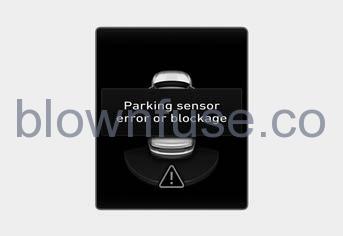
WARNING
- Reverse Parking Distance Warning is a supplemental function. The operation of Reverse Parking Distance Warning can be affected by several factors (including environmental conditions). It is the responsibility of the driver to always check the rearview before and while parking.
- Your new vehicle warranty does not cover any accidents or damage to the vehicle due to the malfunction of the Reverse Parking Distance Warning.
- Pay close attention when driving near objects, pedestrians, and especially children. Some objects may not be detected by the ultrasonic sensors, due to the object’s distance, size or material, all of which can limit the effectiveness of the sensor.
Limitations of Reverse Parking Distance Warning
- Reverse Parking Distance Warning may not operate normally when:
- Moisture is frozen to the sensor
- The sensor is covered with foreign material, such as snow or water (Reverse Parking Distance Warning will operate normally when such foreign material are removed.)
- The weather is extremely hot or cold
- The sensor or sensor assembly is disassembled
- The surface of the sensor has been subjected to a hard impact
- The surface of the sensor has been scratched by a sharp object
- The sensors or their surrounding area are directly sprayed with a high-pressure washer
- Reverse Parking Distance Warning may malfunction when:
- Heavy rain or water spray is present
- Water flows on the surface of the sensor
- Affected by another vehicle’s sensors
- The sensor is covered with snow
- Driving on uneven roads, gravel roads, or bushes
- Objects that generate ultrasonic waves are near the sensor
- Installing the license plate differently from the original location
- The vehicle bumper height or ultrasonic sensor installation has been modified
- Attaching equipment or accessories around the ultrasonic sensors
- The following objects may not be detected:
- Sharp or slim objects, such as ropes, chains, or small poles.
- Objects, which tend to absorb sensor frequency, such as clothes, spongy material, or snow.
- Objects smaller than 40 in. (100 cm) in length and narrower than 6 in. (14 cm) in diameter.
- Pedestrians, animals or objects that are very close to the ultrasonic sensors
- Parking Distance Warning Indicators may be displayed differently from the actual detected location when the obstacle is located between the sensors.
- Parking Distance Warning indicator may not occur sequentially depending on vehicle speed or obstacle shape.
- If the Reverse Parking Distance Warning needs repair, have the vehicle inspected by an authorized HYUNDAI dealer.
FORWARD/REVERSE PARKING DISTANCE WARNING (PDW) (IF EQUIPPED)
Forward/Reverse Parking Distance Warning will help warn the driver if an obstacle is detected within a certain distance when the vehicle is moving forward or in reverse at low speeds.
Detecting sensor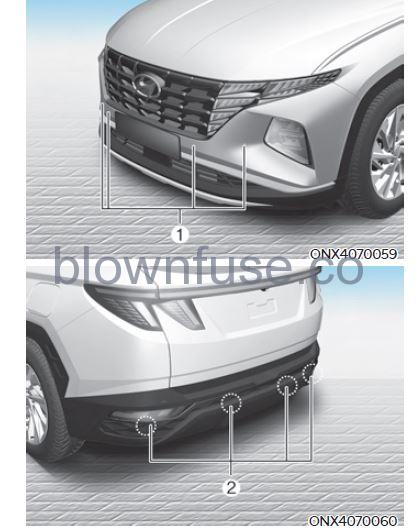
Refer to the picture above for the detailed location of the detecting sensors.
Forward/Reverse Parking Distance Warning Settings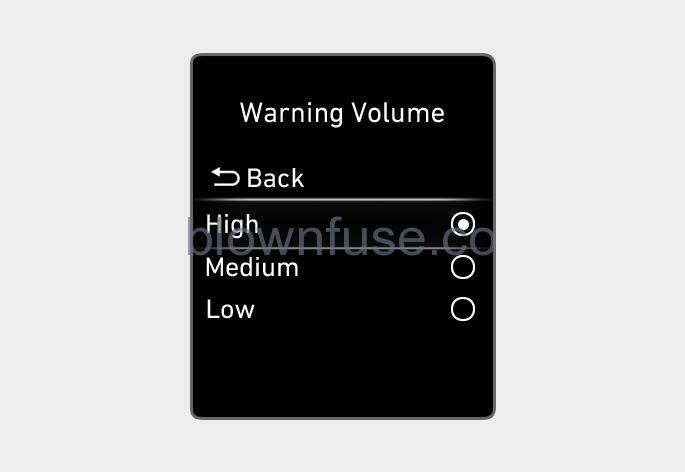
Warning Volume
Select ‘Driver Assistance → Warning Volume’ from the cluster or infotainment system Settings menu to change the Warning Volume to ‘High’, ‘Medium’, or ‘Low’ for forwarding/Reverse Parking Distance Warning. If you change the Warning Volume, the Warning Volume of other Driver Assistance systems may change.
Parking Distance Warning Auto On
To use the Parking Distance Warning Auto On function, select ‘Driver Assistance → Parking Safety → Parking Distance Warning Auto On’ from the cluster or infotainment system Settings menu.
Forward/Reverse Parking Distance Warning Operation
Operating button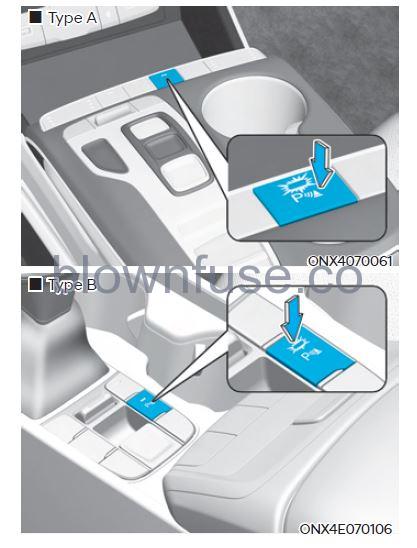
Parking Safety button
- Press the Parking Safety ( ) button to turn on the Forward/Reverse Parking Distance Warning. Press the button again to turn off the function.
- When the Forward/Reverse Parking Distance Warning is off (button indicator light off), if you shift the gear to R (Reverse), the Forward/Reverse Parking Distance Warning will automatically turn on.
- When the Forward/Reverse Parking Distance Warning turns on, the button indicator light will turn on. If the vehicle speed is above 12 mph (20 km/h), the Forward/Reverse Parking Distance Warning will turn off (button indicator light off).
Forward Parking Distance Warning
- Forward Parking Distance Warning will operate when one of the conditions is satisfied.
- The gear is shifted from R (Reverse) to D (Drive) with Reverse Parking Distance Warning on
- The gear is in D (Drive) and the Parking Safety button indicator light is on
- ‘Parking Distance Warning Auto On’ is selected from the Settings menu and the gear is in D (Drive)
- Forward Parking Distance Warning helps detect a person, animal or object in front when the vehicle’s forward speed is below 6 mph (10 km/h).
- Forward Parking Distance Warning does not operate when the vehicle’s forward speed is above 6 mph (10 km/h) even when the Parking Safety button indicator is on. Forward Parking Distance Warning will operate again when the vehicle’s forward speed decreases below 6 mph (10 km/h) while the Parking Safety button indicator is on.
- When ‘Parking Distance Warning Auto On’ is selected, the Parking Safety button indicator light stays on.
Distance from object
Warning indicator Warning sound
Driving forward 24~40 in. (60~100 cm) 
Buzzer beeps intermittently 12~24 in. (30~60 cm) 
Beeps more frequently within 12 in. (30 cm)

Beeps continuously - When ‘Parking Distance Warning Auto On’ is deselected, and the vehicle’s forward speed is above 12 mph (20 km/h), the Parking Safety button indicator will turn off. Although you drive below 6 mph (10 km/h), Forward Parking Distance Warning will not turn on.
- The corresponding indicator will illuminate whenever each ultrasonic sensor detects a person, animal or object in its sensing range. Also an audible warning will sound.
- When more than two objects are detected at the same time, the closest one will be warned with an audible warning.
- The shape of the indicator in the illustration may differ from the actual vehicle.
Reverse Parking Distance Warning
- Reverse Parking Distance Warning will operate when the gear is in R (Reverse).
- Reverse Parking Distance Warning helps detect a person, animal or object in the rear when the vehicle’s rearward speed is below 6 mph (10 km/h).
- When the vehicle’s rearward speed is below 6 mph (10 km/h), both the front and rear ultrasonic sensors will helps detect objects. However, the front ultrasonic sensors can helps detect a person, animal or object when it is within 24 in. (60 cm) from the sensors
Distance from object
Warning indicator Warning sound
Driving rearward 24~48 in. (60~120 cm) 
Buzzer beeps intermittently 12~24 in. (30~60 cm) 
Beeps more frequently within 12 in. (30 cm)

Beeps continuously - The corresponding indicator will illuminate whenever each ultrasonic sensor detects a person, animal or object in its sensing range. Also an audible warning will sound.
- When more than two objects are detected at the same time, the closest one will be warned with an audible warning.
- The shape of the indicator in the illustration may differ from the actual vehicle.
Forward/Reverse Parking Distance Warning Malfunction and Precautions
Forward/Reverse Parking Distance Warning malfunction
After starting the engine, a beep will sound when the gear is shifted to R (Reverse) to indicate Forward/Reverse Parking Distance Warning is operating normally. However, if one or more of the following occurs, first check whether the ultrasonic sensor is damaged or blocked with foreign material. If it still does not work properly, have the vehicle inspected by an authorized HYUNDAI dealer.
- The audible warning does not sound.
- The buzzer sounds intermittent.
- The ‘Parking sensor error or blockage’ warning message appears on the cluster.
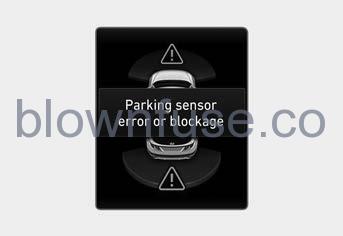
WARNING
- Forward/Reverse Parking Distance Warning is a supplemental function. The operation of forwarding/Reverse Parking Distance Warning can be affected by several factors (including environmental conditions). It is the responsibility of the driver to always check the front and rear views before and while parking.
- Your new vehicle warranty does not cover any accidents or damage to the vehicle due to the malfunction of the forwarding/Reverse Parking Distance Warning.
- Pay close attention when driving near objects, pedestrians, and especially children. Some objects may not be detected by the ultrasonic sensors, due to the objects distance, size or material, all of which can limit the effectiveness of the sensor.
Limitations of forwarding/Reverse Parking Distance Warning
- Forward/Reverse Parking Distance Warning may not operate normally when:
- Moisture is frozen to the sensor
- The sensor is covered with foreign material, such as snow or water (Forward/Reverse Parking Distance Warning will operate normally when such foreign material is removed.)
- The weather is extremely hot or cold
- The sensor or sensor assembly is disassembled
- The surface of the sensor has been subjected to a hard impact
- The surface of the sensor has been scratched by a sharp object
- The sensors or their surrounding area are directly sprayed with a high-pressure washer
- Forward/Reverse Parking Distance Warning may malfunction when:
- Heavy rain or water spray is present
- Water flows on the surface of the sensor
- Affected by another vehicle’s sensors
- The sensor is covered with snow
- Driving on uneven roads, gravel roads, or bushes
- Objects that generate ultrasonic waves are near the sensor
- Installing the license plate differently from the original location
- The vehicle bumper height or ultrasonic sensor installation has been modified
- Attaching equipment or accessories around the ultrasonic sensors
- The following objects may not be detected:
- Sharp or slim objects, such as ropes, chains, or small poles.
- Objects, tend to absorb sensor frequency, such as clothes, spongy material, or snow.
- Objects smaller than 40 in. (100 cm) in length and narrower than 6 in. (14 cm) in diameter.
- Pedestrians, animals, or objects that are very close to the ultrasonic sensors
- Parking Distance Warning Indicators may be displayed differently from the actual detected location when the obstacle is located between the sensors.
- The parking Distance Warning indicator may not occur sequentially depending on vehicle speed or obstacle shape.
- If Forward/Reverse Parking Distance Warning needs repair, have the vehicle inspected by an authorized HYUNDAI dealer.
REVERSE PARKING COLLISION-AVOIDANCE ASSIST (PCA) (IF EQUIPPED)
Reverse Parking Collision-Avoidance Assist will warn the driver or will assist with braking to help reduce the possibility of collision with a pedestrian or an object when backing up.
Detecting sensor
Refer to the picture above for the detailed location of the detecting sensors.
Reverse Parking Collision-Avoidance Assist Settings
Setting features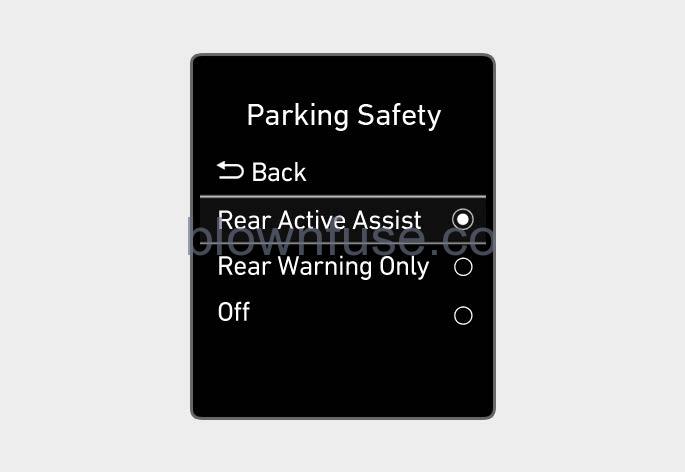
Parking Safety With the engine on, select or deselect ‘Driver Assistance → Parking Safety’ from the Settings menu to set whether or not to use each function.
- If ‘Rear Active Assist’ is selected, Reverse Parking Collision-Avoidance Assist will warn the driver and assist with braking when a collision with a pedestrian or an object is imminent.
- If ‘Rear Warning Only’ is selected, Reverse Parking Collision-Avoidance Assist will warn the driver when a collision with a pedestrian or an object is imminent. Braking will not be assisted.
- If ‘Off’ is selected, Reverse Parking Collision-
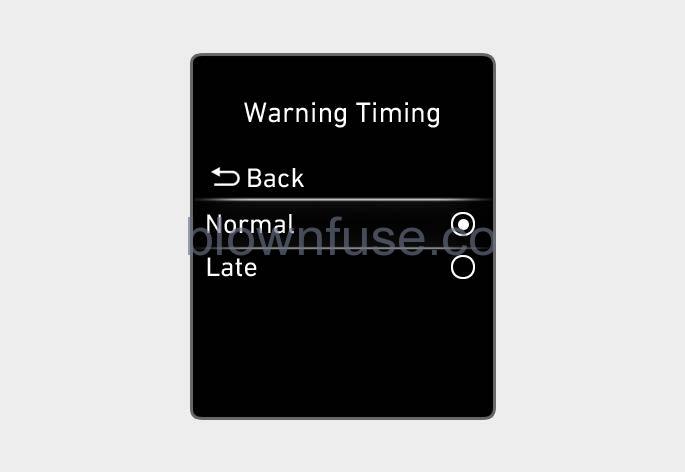
Warning Timing
With the engine on, select ‘Driver Assistance → Warning Timing’ from the Settings menu to change the initial warning activation time for Reverse Parking Collision-Avoidance Assist. When the vehicle is first delivered, Warning Timing is set to ‘Normal’. If ‘Normal’ feels sensitive, change the settings to Late. If you change the Warning Timing, the warning time of other Driver Assistance systems may change.
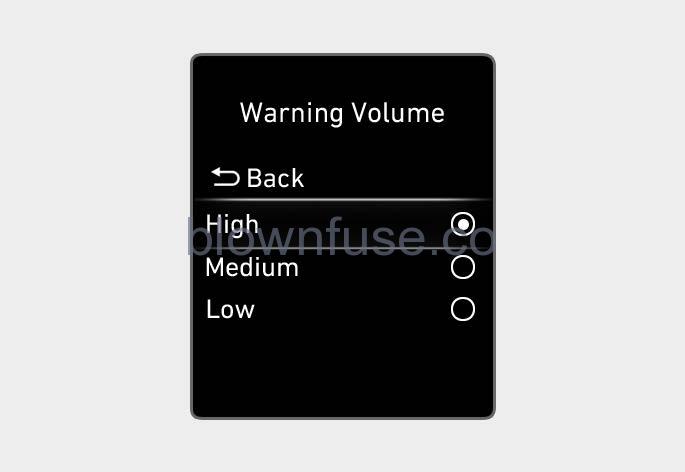
Warning Volume
With the engine on, select ‘Driver Assistance → Warning Volume’ from the Settings menu to change the Warning Volume to ‘High’, ‘Medium’, or ‘Low’ for forwarding Collision-Avoidance Assist. If you change the Warning Volume, the Warning Volume of other Driver Assistance systems may change
Reverse Parking Collision-Avoidance Assist Operation
Operating conditions If ‘Rear Active Assist’ or ‘Rear Warning Only’ is set from the Settings menu, Reverse Parking Collision-Avoidance Assist will be in the ready status when the following conditions are satisfied:
- The liftgate is closed
- The gear is shifted to R (Reverse)
- Vehicle speed is below 6 mph (10 km/h)
- Reverse Parking Collision-Avoidance Assist components such as the rearview camera and the rear ultrasonic sensors are in normal conditions When Reverse Parking Collision-Avoidance Assist activates, a line appears behind the vehicle image in the instrument cluster.
Reverse Parking Collision-Avoidance Assist operates only once after the gear is shifted to R (Reverse). To reactivate Reverse Parking Collision-Avoidance Assist, shift the gear from another gear to R (Reverse).
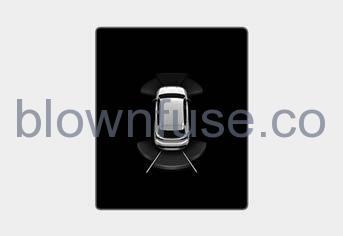
Rear Active Assist
- If Reverse Parking Collision-Avoidance Assist detects a risk of collision with a pedestrian or an object, Reverse Parking Collision-Avoidance Assist will warn the driver with an audible warning and warning message on the cluster. When Rear View Monitor is operating, a warning will appear on the infotainment system screen.
- If Reverse Parking Collision-Avoidance Assist detects an imminent collision with a pedestrian or an object behind the vehicle, Reverse Parking Collision-Avoidance Assist will assist you with braking. The driver needs to pay attention as the brake assist will end within 2 seconds. The driver must immediately depress the brake pedal and check the vehicle’s surroundings.
- Brake control will end when:
- The gear is shifted to P (Park) or D (Drive).
- The driver depresses the brake pedal with sufficient power
- Braking assist has lasted for approximately 2 seconds
- The warning will turn off when:
- The driver shifts the gear to P (Park), N (Neutral), or D (Drive)
- The brake control may not operate properly depending on the status of ESC (Electronic Stability Control). There will only be a warning when:
- The ESC (Electronic Stability Control) warning light is on
- ESC (Electronic Stability Control) is engaged in a different function
Rear Warning Only
- If Reverse Parking Collision-Avoidance Assist detects a risk of collision with a pedestrian or an object, Reverse Parking Collision-Avoidance Assist will warn the driver with an audible warning and warning message on the cluster. When Rear View Monitor is operating, a warning will appear on the infotainment system screen.
- If ‘Rear Warning Only’ is selected, braking will not be assisted.
- The warning will turn off when the gear is shifted to P (Park), N (Neutral), or D (Drive).
Reverse Parking Collision-Avoidance Assist Malfunction and Limitations
Reverse Parking Collision-Avoidance Assist malfunction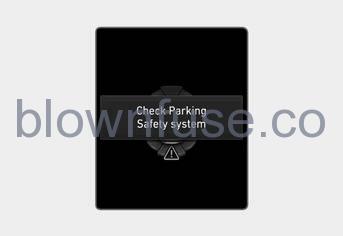
When Reverse Parking Collision-Avoidance Assist or other related functions are not working properly, the ‘Check Parking Safety system’ warning message will appear on the cluster, and Reverse Parking Collision-Avoidance Assist will turn off automatically. We recommend that the vehicle be inspected by an authorized HYUNDAI dealer.
Reverse Parking Collision-Avoidance Assist disabled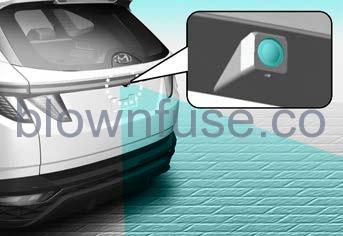
- The rearview camera is used as a detecting sensor to detect pedestrians. If the camera lens is covered with foreign material, such as snow or rain, it may adversely affect camera performance and Reverse Parking Collision-Avoidance Assist may not operate normally. Always keep the camera lens clean.
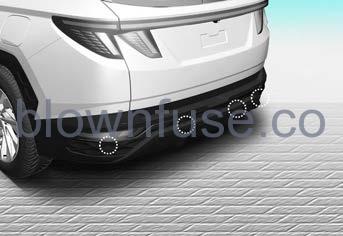
- The rear ultrasonic sensors are located inside the rear bumper to detect objects in the rear area. If the sensors are covered with foreign material, such as snow or rain, it may adversely affect sensor performance and Reverse Parking Collision-Avoidance Assist may not operate normally. Always keep the rear bumper clean.
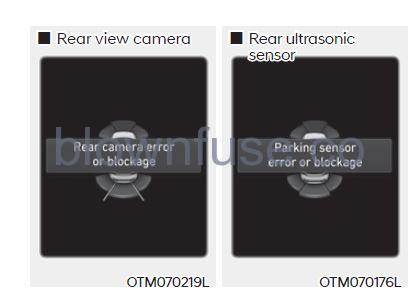
- The ‘Rear camera error or blockage’ or ‘Parking sensor error or blockage’ warning message will appear on the cluster if the following situations occur:
- The rearview camera or rear ultrasonic sensor(s) is covered with foreign material, such as snow or rain, etc.
- There is inclement weather, such as heavy snow, heavy rain, etc.
- If this occurs, Reverse Parking Collision- Avoidance Assist may turn off or may not operate properly. Check whether the rearview camera and rear ultrasonic sensors are clean.
Limitations of Reverse Parking Collision-Avoidance Assist
Reverse Parking Collision-Avoidance Assist may not assist in braking or warn the driver even if there are pedestrians or objects under the following circumstances:
- Any non-factory equipment or accessory is installed
- Your vehicle is unstable due to an accident or other causes
- Bumper height or rear ultrasonic sensor installation has been modified
- The Rearview camera or rear ultrasonic sensor(s) is damaged
- The Rearview camera or the rear ultrasonic sensor(s) is stained with foreign material, such as snow, dirt, etc.
- The Rearview camera is obscured by a light source or by inclement weather, such as heavy rain, fog, snow, etc.
- The surrounding is very bright or very dark
- The outside temperature is very high or very low
- The wind is either strong (above 12 mph (20 km/h)) or blowing perpendicular to the rear bumper
- Objects generating excessive noise, such as vehicle horns, loud motorcycle engines or truck air brakes, are near your vehicle
- An ultrasonic sensor with a similar frequency is near your vehicle
- There is a ground height difference between the vehicle and the pedestrian
- The image of the pedestrian in the rearview camera is indistinguishable from the background
- The pedestrian is near the rear edge of the vehicle
- The pedestrian is not standing upright
- The pedestrian is either very short or very tall for Reverse Parking Collision-Avoidance Assist to detect
- The pedestrian or cyclist is wearing clothing that easily blends into the background, making it difficult to detect
- The pedestrian is wearing clothing that does not reflect ultrasonic waves well
- The size, thickness, height, or shape of the object does not reflect ultrasonic waves well (e.g., pole, bush, curbs, carts, edge of a wall, etc.)
- The pedestrian or the object is moving
- The pedestrian or the object is very close to the rear of the vehicle
- A wall is behind the pedestrian or the object
- The object is not located at the rear center of your vehicle
- The object is not parallel to the rear bumper
- The road is slippery or inclined
- The driver backs up the vehicle immediately after shifting to R (Reverse)
- The driver accelerates or circles the vehicle
Reverse Parking Collision-Avoidance Assist may unnecessarily warn the driver or assist with braking even if there are no pedestrians or objects under the following circumstances:
- Any non-factory equipment or accessory is installed
- Your vehicle is unstable due to an accident or other causes
- Bumper height or rear ultrasonic sensor installation has been modified
- Your vehicle height is low or high due to heavy loads, abnormal tire pressure, etc.
- The Rearview camera or the rear ultrasonic sensor(s) is stained with foreign material, such as snow, dirt, etc.
- The pattern on the road is mistaken for a pedestrian
- There is shadow or light reflecting on the ground
- Pedestrians or objects are around the path of the vehicle
- Objects generating excessive noise, such as vehicle horns, loud motorcycle engines or truck air brakes, are near your vehicle
- Your vehicle is backing towards a narrow passage or parking space
- Your vehicle is backing towards an uneven road surface, such as an unpaved road, gravel, bump, gradient, etc.
- A trailer or carrier is installed on the rear of your vehicle
- An ultrasonic sensor with a similar frequency is near your vehicle
WARNING
Take the following precautions when using Reverse Parking Collision-Avoidance Assist:
- Always pay extreme caution while driving. The driver is responsible for controlling the brake for safe driving.
- Always pay attention to road and traffic conditions while driving, whether or not there is a warning.
- Always look around your vehicle to make sure there are no pedestrians or objects before moving the vehicle.
- The performance of Reverse Parking Collision-Avoidance Assist may vary under certain conditions. If the vehicle speed is above 2 mph (4 km/h), Reverse Parking Collision-Avoidance Assist will provide collision avoidance assist only when pedestrians are detected. Always look around and pay attention when backing up your vehicle.
- Some objects may not be detected by the rear ultrasonic sensors due to the object’s distance, size, or material, all of which can limit the effectiveness of the sensor.
- Reverse Parking Collision-Avoidance Assist may not operate properly or may operate unnecessarily depending on the road conditions and the surroundings.
- Do not solely rely on Reverse Parking Collision-Avoidance Assist. Doing so may lead to vehicle damage or injuries.
CAUTION
- Noise may be heard when sudden braking occurs to avoid a collision.
- If any other warning sound such as the seat belt warning chime is already generated, the Reverse Parking Collision-Avoidance Assist warning may not sound.
- Reverse Parking Collision-Avoidance Assist may not work properly if the bumper has been damaged, replaced or repaired.
- Reverse Parking Collision-Avoidance Assist may not operate normally if interfered by strong electromagnetic waves.
- Playing the vehicle audio system at a high volume may prevent passengers from hearing Reverse Parking Collision-Avoidance Assist warning sounds.
- Turn off Reverse Parking Collision-Avoidance Assist when towing a trailer. If towing and moving in reverse, Reverse Parking Collision-Avoidance Assist will activate as it detects the trailer.
CAUTION
Take the following precautions to maintain optimal performance of the detecting sensors:
- Always keep the rearview camera and rear ultrasonic sensors clean.
- Do not use any cleaner containing acid or alkaline detergents when cleaning the rearview camera lens. Use only a mild soap or neutral detergent, and rinse thoroughly with water.
- Do not spray the rearview camera or the rear ultrasonic sensors or their surrounding area directly with a high-pressure washer. It may cause the rearview camera or the rear ultrasonic sensors to malfunction.
- Do not apply objects, such as a bumper sticker or a bumper guard, near the rearview camera or rear ultrasonic sensors or apply paint to the bumper. Doing so may adversely affect the performance of Reverse Parking Collision-Avoidance Assist.
- Never disassemble or strike the rearview camera or the rear ultrasonic sensors components.
- Do not strike or pry the rearview camera or the rear ultrasonic sensors. Reverse Parking Collision-Avoidance Assist may not operate properly if the rearview camera or the rear ultrasonic sensor(s) is forcibly moved out of proper alignment. Has the vehicle been inspected by an authorized HYUNDAI dealer?
Information
Reverse Parking Collision-Avoidance Assist can detect a pedestrian or an object when:
- A pedestrian is standing behind the vehicle
- A large obstacle, such as a vehicle, is parked in the rear center of your vehicle
REMOTE SMART PARKING ASSIST (RSPA) (IF EQUIPPED)
Remote Smart Parking Assist uses vehicle sensors to help the driver park and exit parking spaces remotely from outside the vehicle by controlling the steering wheel, vehicle speed and gearshifts.
| Function | Description |
|
Remote Forward/ Backward |
Remotely moving forward/ backward |
|
OJX1079037 |
- The remote Forward/Backward function helps the driver move the vehicle forward or Backward from outside the vehicle using the smart key.
- When Remote Smart Parking Assist operates, Surround View Monitor and Parking Distance Warning will also operate. For more details, refer to the “Surround View Monitor (SVM) and “Parking Distance Warning (PDW)” sections in chapter 7.
Detecting sensor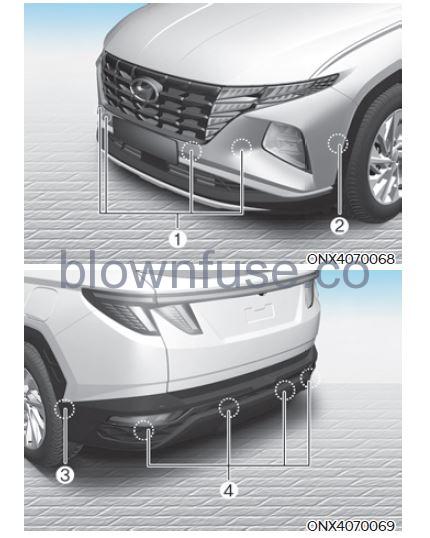
- Front ultrasonic sensors,
- Front side ultrasonic sensors,
- Rear side ultrasonic sensors,
- Rear ultrasonic sensors
Refer to the picture above for the detailed location of the detecting sensors.
CAUTION
Take the following precautions to maintain optimal performance of the detecting sensors:
- Never disassemble the detecting sensor or sensor assembly, or apply any impact on it.
- If the detecting sensor has been replaced or repaired, we recommend that you have your vehicle inspected by an authorized HYUNDAI dealer.
- Remote Smart Parking Assist may malfunction if the vehicle bumper height or ultrasonic sensor installation has been modified or damaged. Any non-factory installed equipment or accessories may also interfere with the sensor performance.
- When the ultrasonic sensor is frozen or stained with snow, dirt, or water, the sensor may not operate until the stains are removed using a soft cloth.
- Do not push, scratch, or strike the ultrasonic sensor. Sensor damage could occur.
- Do not spray the ultrasonic sensors or their surrounding area directly with a high-pressure washer.
Remote Smart Parking Assist Settings
Setting features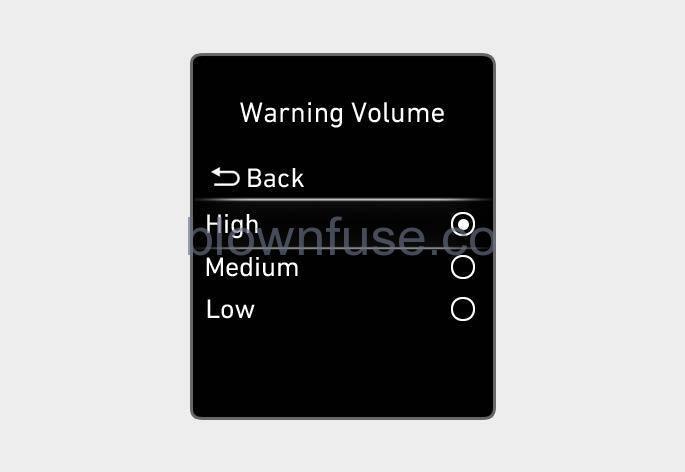
Warning Volume
- With the engine on, select ‘Driver Assistance → Warning Volume’ from the Settings menu to change the Warning Volume to ‘High’, ‘Medium’ or ‘Low’ for Forward Collision-Avoidance Assist.
- If you change the Warning Volume, the Warning Volume of other Driver Assistance systems may change.
Remote Smart Parking Assist Operation Remote Smart Parking Assist button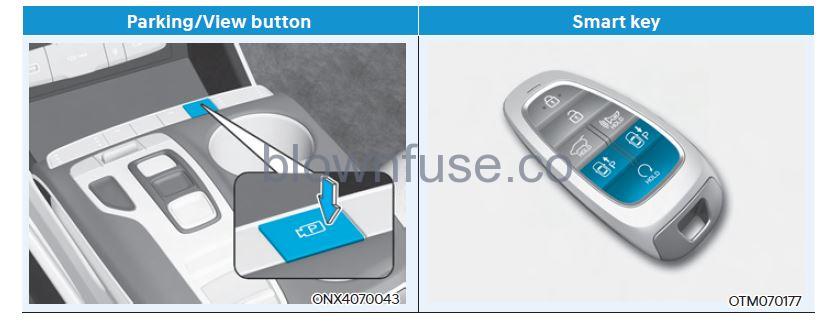
| Location | Name | Symbol | Description |
|
Inside vehicle |
Parking/View button |
 |
• Press and hold the Parking/View button to turn on Remote Smart Parking Assist. Also,
Forward/Reverse Parking Distance warning will automatically turn on. |
| Parking Safety button |  |
• Press the Parking Safety button while Remote Smart Parking Assist is operating to end Remote Smart Parking Assist operation. | |
|
Smart key |
Remote Start button |

|
• Press the Remote Start button after the door is locked with the engine off to start the engine remotely.
• Press the Remote Start button while the Remote Forward/Reverse function is operating to end function operation. |
| Forward button |  |
• When using the Remote Forward/Reverse function, the vehicle moves in the direction of the button while the button is pressed. |
|
| Backward button |  |
Remote Forward/Backward Operating order
Remote Forward/Backward operates in the following order:
- Getting ready to remotely move forward and backward
- Remotely moving forward and backward
Getting ready to remotely move forward and in reverse
There are two ways to operate Remote Forward/Backward function. 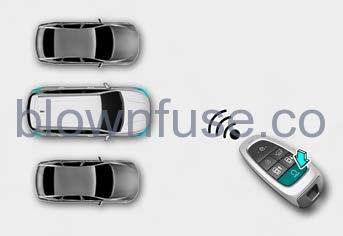 Method (1) Using the function with engine off
Method (1) Using the function with engine off
- Within a certain range from the vehicle press the door lock ( ) button on the smart key and lock all doors.
- Press and hold the Remote Start button ( ) within 4 seconds until the engine starts.
- For more details on remotely starting the engine, refer to the “Remote Start” section in chapter 6.
Information
If the vehicle is remotely started that has been parked in cold weather for a long time, the operation of the Remote Forward/ Backward function may be delayed depending on the engine condition.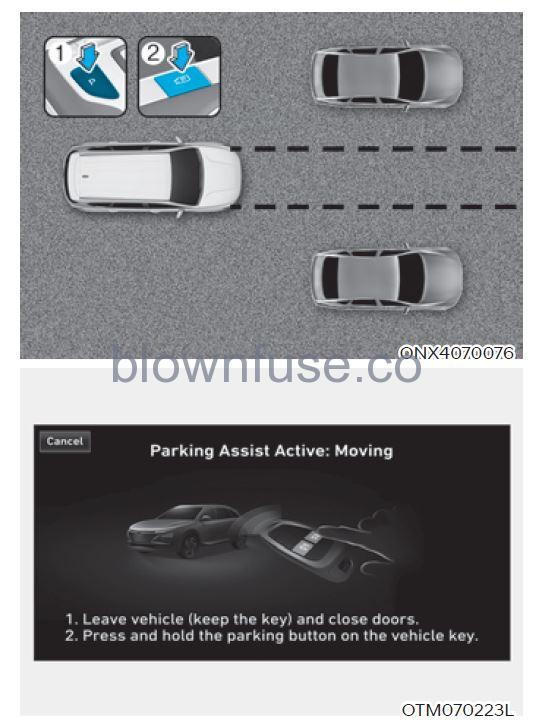
Method (2) Using the function with the engine on
- Park the vehicle in front of the space where you want to use the Remote Forward/Backward function, and shift the gear to P (Park).
- Press and hold the Parking/View ( ) button to turn on Smart Parking Assist. A message ‘Under Remote Control’ will appear on the infotainment system screen.
- Get out of the vehicle with the smart key and close all doors.
Agree’ must be selected on the infotainment system screen and the infotainment system has to operate properly to use Remote Forward/ Backward function.
Remotely moving forward and backward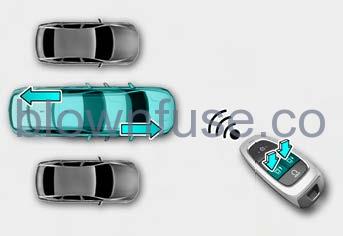
- Press and hold one of the Forward ( ) or Backward ( ) buttons on the smart key. Remote Smart Parking Assist will automatically control the steering wheel, vehicle speed, and gearshift. The vehicle will move in the direction of the button pressed.
- While the Remote Forward/Backward function is operating, if you do not hold down the Forward ( ) or Backward ( ) button, the vehicle will stop and function control will pause. The function will start operating again when the button is pressed and held again.
- When the vehicle reaches the target location, release the smart key Forward or Backward button
- When the driver gets in the vehicle with the smart key, a message will appear informing the driver Remote Forward/Backward function is complete on the infotainment system screen and the engine will remain on. In addition, when the Remote Start ( ) button is pressed on the smart key from outside the vehicle, a message will appear informing the driver Remote Forward/Backward function is complete and the engine will turn off.
- Check that all smart keys are outside the vehicle when using the Remote Forward/Backward function.
- The remote Forward/Backward function will operate only when the smart key is within 13 ft. (4 m) from the vehicle. If there is no vehicle movement even when the Forward or Backward button is pressed on the smart key, check the distance to the vehicle and press the button again.
- The detecting range of the smart key may vary depending on the surroundings that are affected by radio waves such as transmission towers, broadcast stations, etc.
- When remotely moving forward using method (1), it is recognized as an exit situation, and the vehicle moves 13 ft. (4 m) to check for pedestrians, animals, or objects around the vehicle. After confirmation, the steering wheel is controlled according to the condition ahead.
- When remotely moving forward using method (2), it is recognized as a parking situation, and will immediately control the steering wheel according to the condition ahead to assist with entering the parking space and aligning the vehicle. However, performance may reduce depending on the pedestrians, animals, shape of objects, location, etc. around the vehicle.
- For moving remotely backward, both method (1) and (2) aligns the steering wheel first, and then will only move the vehicle straight.
- When remotely moving Forward/ Backward is completed, the vehicle will automatically shift to P (Park) and engage EPB (Electronic Parking Brake).
CAUTION
- When using the Remote Remote Forward/Backward function, make sure that all passengers have gotten out of the vehicle.
- If the vehicle’s battery is discharged or Remote Smart Parking Assist malfunctions when parked in a narrow parking space, Remote Forward/Backward function will not operate. Always park your vehicle in a space wide enough for you to get in or out of your vehicle.
- Please note that depending on the parking space, you may not be able to exit from the space you have entered by using the Remote Forward/ Backward function.
- After parking, the surrounding may change due to the movement of surrounding vehicles. If this occurs, Remote Forward/Backward function may not operate.
- Before leaving the vehicle, close windows, and sunroofs, and make sure the engine is off before locking the doors.
Remote Forward/Backward Parking function operation status
| Operation status |
Smart key LED |
Hazard warning light |
| Under control | Green LED continuously blinks |
– |
|
Pause |
Red LED continuously blinks |
Blinks |
|
Off |
Red LED illuminates for 4 seconds and then turns off | Blinks 3 times and turns off |
|
Complete |
Green LED illuminates for 4 seconds and then turns off | Blinks 1 time and turns off |
- Operation status by the hazard warning light may not be applicable based on the regulation of your country.
- If the smart key is not within the operating range of the vehicle (approximately 13 ft. (4 m)), the smart key LED will not illuminate or blink. Use the smart key within the operating range.
How to turn off Remote Forward/ Backward function while operating
- Press the Parking/View ( ) button while the infotainment system screen guides the driver using method 2.
- Shift the gear except to P (Park) while the infotainment system screen guides the driver using method 2.
- Press the Parking Safety ( ) button or select ‘Cancel’ on the infotainment system screen.
- Press the Remote Start ( ) button on the smart key while the vehicle is being controlled by RRemote Forward/Backward function.
- The remote Forward/Backward function will turn off. At this time, the engine will turn off.
- Get on the vehicle with the smart key. The remote Forward/Backward function will turn off. At this time, the engine will remain on.
The function will pause in the following conditions when:
- There is a pedestrian, animal, or object in the direction the vehicle is moving
- The door or liftgate is open
- The Forward ( ) or Backward ( ) button is not continuously pressed
- Simultaneously pressing multiple buttons on a smart key
- The smart key is not operated within 13 ft. (4 m) from the vehicle
- The button of another smart key is pressed in addition to the operating smart key
- Blind-Spot Collision-Avoidance Assist or Rear Cross-Traffic Collision-Avoidance Assist operates while the vehicle is being controlled in the backward direction.
- The vehicle moves 22 ft. (7 m) while the smart key is pressed with the Remote Forward/Backward function (maximum travel distance per button press)
When Remote Forward/Backward function is paused, the vehicle will stop. If the condition that made the function pause disappears, the function may operate again.
The function will cancel in the following conditions when:
- The steering wheel is steered
- The gear is shifted while the vehicle is moving
- Operating EPB while the vehicle is moving
- The engine hood is open
- The brake pedal or accelerator pedal is depressed when all the doors are closed
- The smart key is outside the vehicle when the brake pedal is depressed while the driver’s door is open
- Rapid acceleration occurs
- Vehicle skid occurs
- The wheel is stuck by an obstacle and cannot move
- There are pedestrians, animals, or objects at the front and rear of the vehicle at the same time
- Approximately 3 minutes and 50 seconds have passed after the Remote Forward/Backward function has started to operate
- The slope of the road exceeds the operational range
- The function is paused for more than 1 minute
- The total travel distance of the vehicle has exceeded 45 ft. (14 m) after Remote Forward/Backward function operation
- The steering wheel, gearshift, braking, and drive controls are not working normally
- There is a problem with the smart key or the smart key battery is low
- ABS, TCS or ESC system operates due to slippery road conditions
- The alarm of the Theft Alarm System sounds
When Remote Forward/Backward function is canceled, the vehicle will automatically stop, shift the gear to P (Park) and engage EPB (Electronic Parking Brake).
Remote Smart Parking Assist Malfunction and Limitations
Remote Smart Parking Assist malfunction
- Remote Smart Parking Assist check When Remote Smart Parking Assist is not working properly, the ‘Check Parking Assist’ warning message will appear on the infotainment system screen. If the message appears, stop using Remote Smart Parking Assist, and have the vehicle inspected by an authorized HYUNDAI dealer.
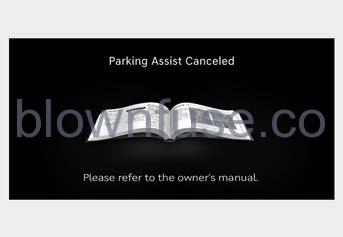
- Remote Smart Parking Assist canceled When Remote Parking Assist is operating, the function can be canceled, and the ‘Parking Assist Canceled’ warning message may appear regardless of the parking order. Other messages may appear depending on the situation. Follow the instructions provided on the infotainment system screen while parking your vehicle with Remote Parking Assist. Always look around and pay attention when using Remote Smart Parking Assist.
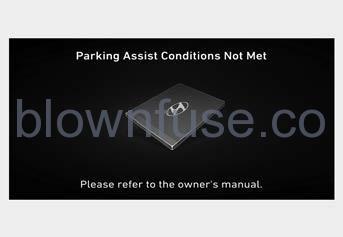
- Remote Smart Parking Assist standby When the ‘Parking Assist Conditions Not Met’ message appears, when Parking/ View ( ) button has been pressed and held Remote Smart Parking Assist is in standby. After a while, press and hold the Parking/View ( ) button again to see if Remote Smart Parking Assist works. The message appears even when the smart key’s battery is low. Check the smart key battery level.
Limitations of Remote Smart Parking Assist
In the following circumstances, Remote Smart Parking Assist performance to park or exit the vehicle may be limited, there may be a risk of collision, or Remote Smart Parking Assist may turn off. Park or exit the vehicle manually if necessary.
- An object is attached to the steering wheel
- The vehicle is installed with a snow chain, spare tire or different size wheel
- Tire pressure is lower or higher than the standard tire pressure
- Your vehicle is loaded with cargo longer or wider than your vehicle or a trailer is connected to your vehicle
- There is a problem with the wheel alignment
- Your vehicle is leaned severely to one side
- Your vehicle is equipped with a trailer hitch
- The license plate is installed differently from the original location
- There is a person, animal or object above or below the ultrasonic sensor when Remote Smart Parking Assist is activated
- The parking space is curved or diagonal
- There is an obstacle such as a person, animal or object (trash can, bicycle, motorcycle, shopping cart, narrow pillar, etc.) near the parking space
- There is a circular pillar or narrow pillar, or a pillar surrounded by objects such as fire extinguishers, etc. near the parking space
- The road surface is bumpy (curbstone, speed bump, etc.)
- The road is slippery
- The parking space is near a vehicle with higher ground clearance or big, such as a truck, etc.
- The parking space is Inclined
- There is heavy wind
- Operating Remote Smart Parking Assist on uneven roads, gravel roads, bushes, etc.
- The performance of the ultrasonic sensor is affected by extremely hot or cold weather
- The ultrasonic sensor is covered with snow or water
- An object that generates ultrasonic waves is nearby
- A wireless device with a transmission function operates near the ultrasonic sensors
- Your vehicle is affected by another vehicle’s Parking Distance Warning
- The sensor is mounted or positioned incorrectly by an impact to the bumper
- When the ultrasonic sensor cannot detect the following objects:
- Sharp or slim objects, such as ropes, chains, or small poles
- Objects smaller than 40 in. (100 cm) in length and narrower than 6 in. (14 cm) in diameter
- Objects which tend to absorb
- sensor frequency, such as clothes, spongy material, or snow Remote Smart Parking Assist may not operate normally under the following circumstances:
- Parking on inclines Parks manually when parking on inclines.
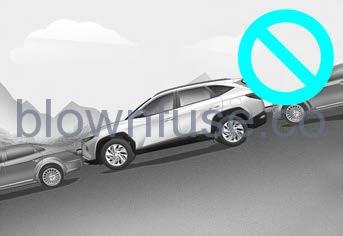
- Parking on uneven road Remote Smart Parking Assist may cancel when the vehicle slips, or the vehicle cannot move due to road conditions such as pebbles or fragmented stones.
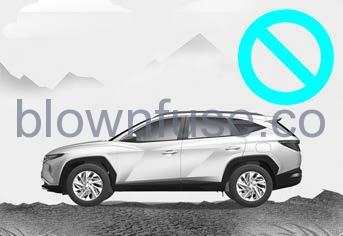
- Parking behind a truck Do not use Remote Smart Parking Assist around vehicles with higher ground clearance, such as a bus, truck, etc. It may lead to an accident.
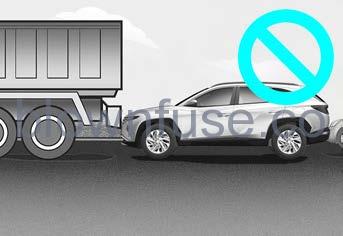
- Parking near a pillar Remote Smart Parking Assist performance may reduce when there is a pillar or pillar surrounded by objects such as a fire extinguisher near the parking space.
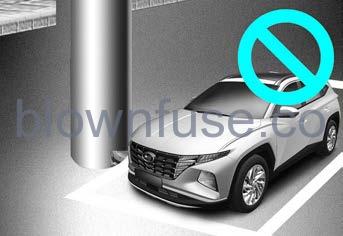
- Parking in a parking space with a vehicle on one side only If Remote Smart Parking Assist is used, when parking in a parking space with a vehicle only on one side, your vehicle may cross the parking line to avoid the parked vehicle.
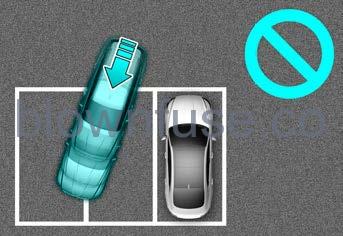
- Parking diagonal Remote Smart Parking Assist does not provide diagonal parking. Even if your vehicle was able to enter the parking space, do not use Remote Smart Parking Assist because the function cannot operate normally.
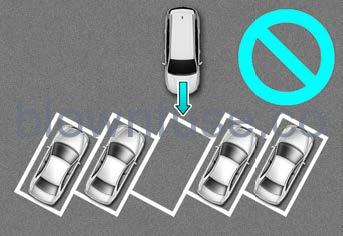
- Parking in snow Snow may interfere with sensor operation, or Remote Smart Parking Assist may cancel if the road is slippery while parking.
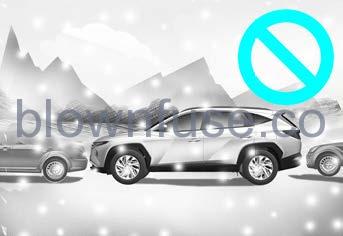
WARNING
Take the following precautions when using Remote Smart Parking Assist:
- The driver is responsible for safe parking and exit when using Remote Smart Parking Assist. Make sure there are no pedestrians, animals or objects around the vehicle when using Remote Smart Parking Assist. When using Remote Smart Parking Assist, stay out of the way in the direction the vehicle moves for your safety.
- Always check surroundings when using Remote Smart Parking Assist. You may collide with pedestrians, animals, or objects if they are near the sensor or are in the sensor’s blind spot area.
- A collision may occur if a pedestrian, animal, or object suddenly appears while Remote Smart Parking Assist is operating.
- Do not use Remote Smart Parking Assist when under the influence of alcohol.
- Do not let children or other people to use the smart key.
- If Remote Smart Parking Assist is used continuously for a long period, it may adversely affect Remote Smart Parking Assist performance.
- Remote Smart Parking Assist may not operate normally if the vehicle needs wheel alignment adjustment such as when the vehicle tilts to one side. Have the vehicle inspected by an authorized HYUNDAI dealer.
- Noise may be heard when braking occurs by Remote Smart Parking Assist or when the brake pedal is depressed by the driver.
- Remote Smart Parking Assist may suddenly apply the brake to avoid a collision.
- Use Remote Smart Parking Assist only in a parking space that is large enough for the vehicle to move safely.
NOTICE
- If the 3rd stage warning (continuous beep) of the Forward/Backward Parking Distance Warning sounds while Remote Smart Parking Assist is operating, it means the obstacle detected is close to your vehicle. At this time, Remote Smart Parking Assist will temporarily stop operating. Make sure there are no pedestrians, animals, or objects around your vehicle.
- Depending on brake operation, the stoplights may come on while the vehicle is moving.
